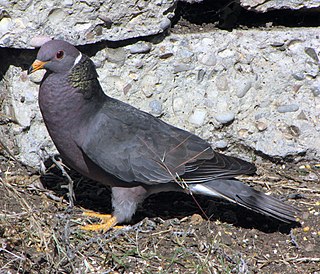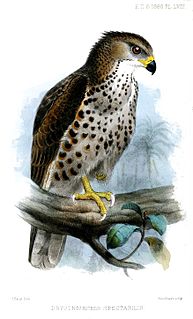
Eagle is the common name for many large birds of prey of the family Accipitridae. Eagles belong to several groups of genera, some of which are closely related. Most of the 60 species of eagle are from Eurasia and Africa. Outside this area, just 14 species can be found—2 in North America, 9 in Central and South America, and 3 in Australia.

The Bonelli's eagle is a large bird of prey. The common name of the bird commemorates the Italian ornithologist and collector Franco Andrea Bonelli. Bonelli is credited with gathering the type specimen, most likely from an exploration of Sardinia. Some antiquated texts also refer to this species as the crestless hawk-eagle. Like all eagles, Bonelli's eagle belongs to the family Accipitridae. Its feathered legs marked it as member of the Aquilinae or booted eagle subfamily. This species breeds from Southern Europe, Africa on the montane perimeter of the Sahara Desert and across the Indian Subcontinent to Indonesia. On Eurasia, this species may be found as far west as Portugal and as far east as southeastern China and Thailand. It is usually a resident breeder. The Bonelli's eagle is often found in hilly or mountainous habitats, with rocky walls or crags, from sea level to 1,500 m (4,900 ft). Habitats are often open to wooded land and can occur in arid to semi-moist climate. This eagle, though it can be considered partially opportunistic, is something of a special predator of certain birds and mammals, especially rabbits, galliforms and pigeons. On evidence, when staple prey populations decline or are locally scarce, Bonelli's eagle switch to being an opportunistic predator of a wide variety of birds. Despite its persistence over a large range and its continued classification as a least concern species by the IUCN, the Bonelli's eagle has declined precipitously in various parts of its range, including almost all of its European distribution, and may face potential local extinction. The species' declines are due to widespread habitat destruction, electrocution from electricity pylons as well as persistent persecution.

Megaloptera is an order of insects. It contains the alderflies, dobsonflies and fishflies, and there are about 300 known species.

The band-tailed pigeon is a medium-sized bird of the Americas. Its closest relatives are the Chilean pigeon and the ring-tailed pigeon, which form a clade of Patagioenas with a terminal tail band and iridescent plumage on their necks. There are at least 8 sub-species, and some authorities split this species into the northern band-tailed pigeon and the southern band-tailed pigeon.

The ribbon seal is a medium-sized pinniped from the true seal family (Phocidae). A seasonally ice-bound species, it is found in the Arctic and Subarctic regions of the North Pacific Ocean, notably in the Bering Sea and Sea of Okhotsk. It is distinguished by its striking coloration, with two wide white strips and two white circles against dark brown or black fur.

The black skimmer is a tern-like seabird, one of three similar birds species in the skimmer genus Rynchops in the gull family Laridae. It breeds in North and South America. Northern populations winter in the warmer waters of the Caribbean and the tropical and subtropical Pacific coasts, but the South American races make only shorter movements in response to annual floods which extend their feeding areas in the river shallows.

Fishflies are members of the subfamily Chauliodinae, belonging to the megalopteran family Corydalidae. They are most easily distinguished from their closest relatives, dobsonflies, by the jaws (mandibles) and antennae. In contrast to the large jaws of dobsonflies, fishfly mandibles are not particularly noticeable or distinctive, and the males have feathery antennae similar to many large moths. Chauliodes pectinicornis, the "summer fishfly", is a well-known species in North America.

The family Corydalidae contains the megalopterous insects known as dobsonflies and fishflies. Making up about one dozen genera, they occur primarily throughout the Northern Hemisphere, both temperate and tropical, and South America.

Hartlaub's gull, also known as the king gull, is a small gull, which is a non-migratory breeding resident endemic to the Atlantic Ocean coastline of South Africa and Namibia. Although it is predominantly coastal or estuarine, it is not a pelagic species, and is rarely seen at sea far from land. It was formerly sometimes considered to be a subspecies of the silver gull, and, as is the case with many gulls, it has traditionally been placed in the genus Larus but is now placed in the genus Chroicocephalus.

The blacktip grouper, also known as the redbanded grouper, blacktipped cod, black-tipped rockcod, footballer cod, red-barred cod, red-barred rockcod, scarlet rock-cod or weathered rock-cod, is a species of marine ray-finned fish, a grouper from the subfamily Epinephelinae which is part of the family Serranidae, which also includes the anthias and sea basses. It is found in the tropical Indo-Pacific region. It is the type species of the genus Epinephelus.

The Congo serpent eagle is a species of bird of prey in the family Accipitridae, and is sometimes placed in the monotypic genus Dryotriorchis by some taxonomic authorities. This species is distributed across the African tropical rainforest, including upper and lower Guinean forests. This serpent eagle specializes in hunting in these forests’ dark understories. It has two subspecies, the nominate subspecies Dryotriorchis spectabilis spectabilis and Dryotriorchis spectabilis batesi. Though monotypic, it appears to be very closely related to Circaetus. This hawk is a medium-sized bird with distinctive short, rounded wings and a long, rounded tail. It is varying shades of brown on its back and has a slight crest. Its breast is white with variable amounts of a rufous wash and, in the nominate subspecies, is covered in round, blackish spots. The subspecies D. s. batesi only has these dots on its flanks. The Congo serpent eagle closely resembles Cassin's hawk-eagle, and some ornithologists believe that this likeness is a rare example of avian mimicry. It is a very vocal raptor, and often is one of the most heard species in its habitat.

The mantled hawk is a South American species of bird of prey in the family Accipitridae.

Cassin's hawk-eagle or Cassin's eagle, is a relatively small eagle in the family Accipitridae. Its feathered legs mark it as member of the Aquilinae or booted eagle subfamily. A forest-dependent species, it occurs in primary rainforests across western, central and (marginally) eastern Africa where it preys on birds and tree squirrels. It was named after John Cassin who first described it in 1865. Due to widespread habitat destruction, its populations are steadily declining but have not yet warranted upgrading its status from Least Concern.

The white-banded swallow is a species of bird in the family Hirundinidae. They are black with white thighs, a white breast, and white bars on the edges of its wings. They have a distinct, deeply forked tail.

Acronicta rumicis, the knot grass moth, is a species of moth which is part of the genus Acronicta and family Noctuidae. It was first described by Carl Linnaeus in his 1758 10th edition of Systema Naturae. It is found in the Palearctic region. A. rumicis lives and feeds on plants located in wide-open areas. At its larval stage, as a caterpillar, it causes such a large impact as a crop pest that it has received much attention and research. A. rumicis feeds on maize, strawberries and other herbaceous plants.

Munidopsis serricornis is a species of squat lobster. It is widely distributed in the world's oceans, being found in the eastern Atlantic Ocean, the western Atlantic Ocean, and the Indo-Pacific. It grows up to a carapace length of 20 millimetres (0.8 in).

Nigronia serricornis has many common names including hellgrammites or fishflies or saw-combed fishflies. The genus Nigronia has one other North American member N. fasciatus which lives in much of the same territory and is quite similar in all regards. They are holometabolous insects with an aquatic larval stage. N. serricornis is a common inhabitant of woodland streams in North America and they are often the largest insect predator found in 2nd and 3rd order streams. The larvae are a sit-and -wait ambush predators that feed on a large variety of invertebrates. Studies have shown that N. serricornis has a varying diet throughout the seasons.

Nigronia fasciata is a megalopterous dark fishfly in the Corydalidae family. The typical size of N. fasciata is 22 to 28 millimeters, or 2.2 to 2.8 centimeters. Range: Eastern United States. Note: not present in Canada.

Archichauliodes diversus is an insect in the subfamily Chauliodinae - the fishflies, though it is often referred to as the New Zealand dobsonfly, despite not being a true dobsonfly. In its larval form it is commonly known by the name toe-biter, and its Māori name is puene. The species is native to New Zealand. Although there are many other species of fishfly in other parts of the world, Archichauliodes diversus is the only species of fishfly in New Zealand.

Zenithoptera fasciata, also known as the rainforest bluewing is a species of dragonfly native to much of the northern half of South America, as well as southern portions of Central America. The species has in the past been known by additional taxonomic names, including: Libellula fasciata, Libellula americana, and Libellula violacea.




















